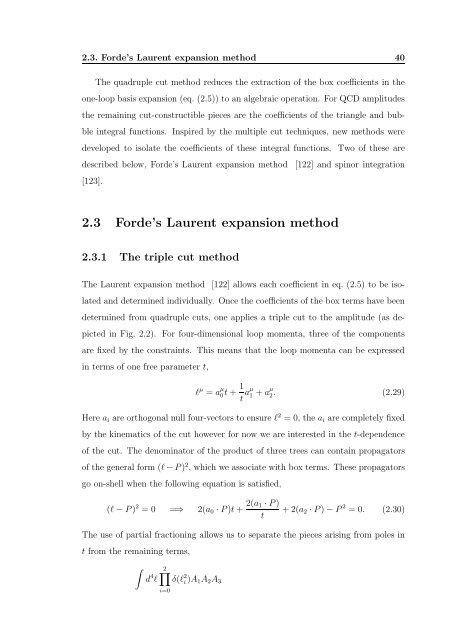Hadronic production of a Higgs boson in association with two jets at ...
Hadronic production of a Higgs boson in association with two jets at ...
Hadronic production of a Higgs boson in association with two jets at ...
Create successful ePaper yourself
Turn your PDF publications into a flip-book with our unique Google optimized e-Paper software.
2.3. Forde’s Laurent expansion method 40The quadruple cut method reduces the extraction <strong>of</strong> the box coefficients <strong>in</strong> theone-loop basis expansion (eq. (2.5)) to an algebraic oper<strong>at</strong>ion. For QCD amplitudesthe rema<strong>in</strong><strong>in</strong>g cut-constructible pieces are the coefficients <strong>of</strong> the triangle and bubble<strong>in</strong>tegral functions. Inspired by the multiple cut techniques, new methods weredeveloped to isol<strong>at</strong>e the coefficients <strong>of</strong> these <strong>in</strong>tegral functions. Two <strong>of</strong> these aredescribed below, Forde’s Laurent expansion method [122] and sp<strong>in</strong>or <strong>in</strong>tegr<strong>at</strong>ion[123].2.3 Forde’s Laurent expansion method2.3.1 The triple cut methodThe Laurent expansion method [122] allows each coefficient <strong>in</strong> eq. (2.5) to be isol<strong>at</strong>edand determ<strong>in</strong>ed <strong>in</strong>dividually. Once the coefficients <strong>of</strong> the box terms have beendeterm<strong>in</strong>ed from quadruple cuts, one applies a triple cut to the amplitude (as depicted<strong>in</strong> Fig. 2.2). For four-dimensional loop momenta, three <strong>of</strong> the componentsare fixed by the constra<strong>in</strong>ts. This means th<strong>at</strong> the loop momenta can be expressed<strong>in</strong> terms <strong>of</strong> one free parameter t,l µ = a µ 0 t + 1 t aµ 1 + aµ 2 . (2.29)Here a i are orthogonal null four-vectors to ensure l 2 = 0, the a i are completely fixedby the k<strong>in</strong>em<strong>at</strong>ics <strong>of</strong> the cut however for now we are <strong>in</strong>terested <strong>in</strong> the t-dependence<strong>of</strong> the cut. The denom<strong>in</strong><strong>at</strong>or <strong>of</strong> the product <strong>of</strong> three trees can conta<strong>in</strong> propag<strong>at</strong>ors<strong>of</strong> the general form (l −P) 2 , which we associ<strong>at</strong>e <strong>with</strong> box terms. These propag<strong>at</strong>orsgo on-shell when the follow<strong>in</strong>g equ<strong>at</strong>ion is s<strong>at</strong>isfied,(l − P) 2 = 0 =⇒ 2(a 0 · P)t + 2(a 1 · P)t+ 2(a 2 · P) − P 2 = 0. (2.30)The use <strong>of</strong> partial fraction<strong>in</strong>g allows us to separ<strong>at</strong>e the pieces aris<strong>in</strong>g from poles <strong>in</strong>t from the rema<strong>in</strong><strong>in</strong>g terms,∫d 4 l2∏δ(l 2 i)A 1 A 2 A 3i=0
















